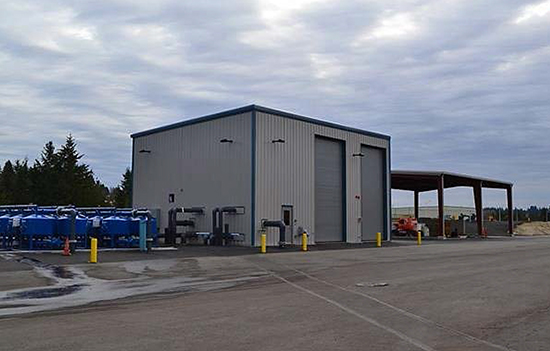|
Subscribe / Renew |
|
|
Contact Us |
|
| ► Subscribe to our Free Weekly Newsletter | |
| home | Welcome, sign in or click here to subscribe. | login |
Construction
| |
 |
January 26, 2015
Future value to engineering profession
Best in State: Gold award
Herrera Environmental
Project: Port of Olympia Stormwater Treatment System feasibility and design
Client: Port of Olympia
Nearly 130 million board feet of logs move through the Port of Olympia’s marine terminal every year. The majority of this 65-acre site is devoted to 25-foot-high stacks of logs, log debarkers and immense log-loading machines.
Every log that moves through the port leaves behind bark and other organic material. This material accumulates and is washed into south Puget Sound, where it is consumed by bacteria and in the process depletes the oxygen supply in the water.
Low oxygen leads to stress and mortality of aquatic life. Due to this, Washington state’s industrial stormwater permit has set benchmarks for stormwater containing oxygen-depleting material, and the Port of Olympia, along with many other log yards, are required to treat their log yard runoff to meet these benchmarks. For the Port of Olympia, this required treatment of 64 million gallons of stormwater each year.
When Herrera began working with the Port of Olympia, the port had a clear goal: Design a system to treat their stormwater and make sure the system is flexible enough to meet changing demands.
At the time of design there were no existing successful log yard treatments for the pollutants found at this site. Herrera designed a 3.25-acre stormwater treatment facility that will meet the state’s benchmark values.
The modular and adaptable design provides the port with flexibility for reducing operating costs should their treatment needs change. The treatment facility design incorporated wastewater treatment technologies to treat highly variable stormwater and used relatively inexpensive pilot testing to guide the design. Gallon for gallon, the system will be less expensive than other technologies, including a passive treatment system originally envisioned, yet without the concerns of long-term reliability or consistency.
The port is now acknowledged by regulators, the community and by other ports as being innovative, progressive and leading the way in protecting Puget Sound.
As Gov. Jay Inslee said at the project’s ribbon cutting, “I’m here on behalf of my three grandchildren because they’re going to have a shot at a clean Puget Sound because of the leadership of the people associated with the port.”
Other Stories:
- National finalist: Platinum award
Magnusson Klemencic Associates - Complexity
Best in State: Gold award
Parametrix - Social/economic sustainability
Best in State: Gold award
Hart Crowser - Future value to engineering profession
Best in State: Gold award
David Evans and Associates - Originality/innovation
Best in State: Gold award
Tetra Tech - Transportation
National finalist: Gold award
Jacobs/GeoEngineers - Structural systems
National finalist: Gold award
CKC Structural Engineers - Structural systems
National finalist: Gold award
HNTB Corp. - Structural systems
National finalist: Gold award
Buckland & Taylor - Structural systems
National finalist: Gold award
Hart Crowser - Exceeds owner/client needs
Best in State: Gold award
Hart Crowser



